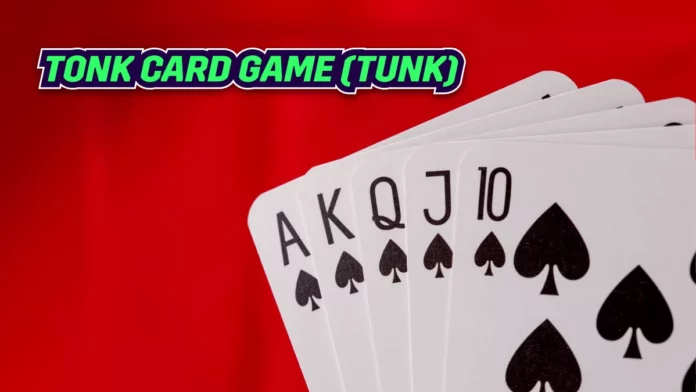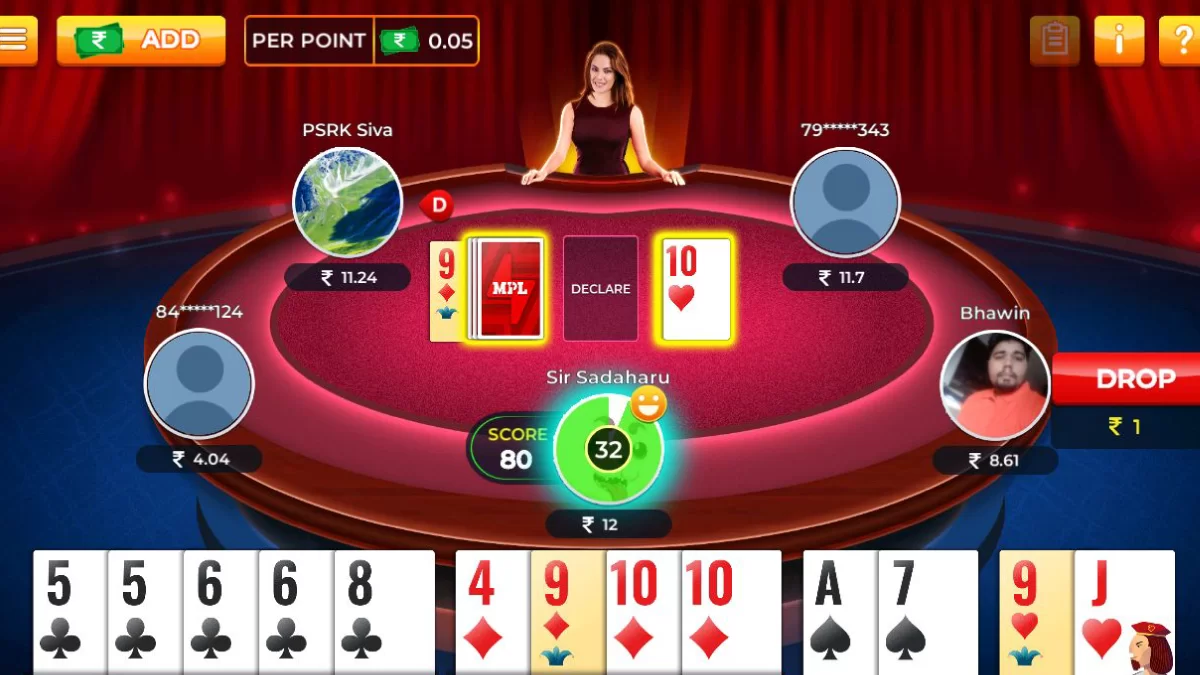The tonk card game, also known as tunk, knot, and Texas tonk, is a matching card game that combines the elements of conquian and rummy games. The game originated in the USA and was quite popular in the 1930s amongst jazz and blues musicians in Louisiana. It was played during the breaks in salons and bars. Tunk was also played in the military barrack and as a popular pastime during lunch breaks.
Tonk is a relatively fast-paced game that can be played between two to our players. The game has numerous variations played by players from diffe ent regions. Therefore, if you play Tonk game with friends, it’s wise to come to a mutual agreement on house rules. On your next game night, you can follow the below tunk game rules and gameplay to breathe life into the game night without any clashes.
Tunk Game Rules
Tonk is a 2 to 4 player game played either for points or wagered money, with a standard deck of cards an two jokers. The stake (the amount to be paid to the winner by every player) is agreed upon before the game starts. The game includes several hands, and each player takes t ns to deal. The jokers used in the game are wild jokers meaning they can be used to substitute any card that a player may need to make a hand.
Card Ranking
The cards in the trunk game are ranked in a high to low order as K, Q, J, 10, 9, 8, 7, 6, 5, 4, 3, 2, A. However, in the Hoyle types of rummy, the aces may either rank high or low. In tunk, kings are high, aces low, and the 2s are wild cards.
Objective of Tunk
The object of the Tonk game is to form matching sets of three or four of a kind groups or sequences of three or more sam suit cards. The goal is to get rid of the cards by grouping them nto spreads. The first player to get rid of all the cards or the player with the least points at the end of the game is declared the winner.
Also Read: How to Play the Whist Card Game? Rules, Gameplay, and Variants
Dealing
Before the game begins, a dealer is selected. To select the dealer, each player draws a card from a shuffled deck, and the player that draws the lowest-value card become the dealer. The dealer then reshuffles the deck and deals seven cards to each player in a clockwise direction.
The remaining un-dealt cards form the stockpile and are placed at the center of t e play area. The topmost card from the stock-pile is turned and placed face-up next to the pile to form the iscard pile. This card is also the up-card or the first card of the discard pile.
The deal passes to every player starting from the dealer’s left; therefore, new players should be seated on the dealer’s right.
How to Play Tonk?
The play begins with the player seated at the dealer’s left and proceeds in a clockwise direction. Each player can draw a card from the stock pile or the discard pile but must discard a card at the end of their turn. The players draw and discard cards to form spreads of sets and runs. Only the player at the left of the dealer can take the first upcard. If the ungrouped cards of the player count five or less, they can declare tunk or knock before discarding. That player then spreads the hand by separating the grouped and ungrouped cards.
Melding
Players must get rid of the cards and reduce the points in hand by melding them into sequen es and sets. Grouping three or more cards of a kind is called a set, and grouping three or more cards of the same suit in a decreasing or increasing order is called run.
A melded set of cards can have up to four cards of the same rank, including two natural cards (if there are jokers). For instance, J♦️ J ♠️ J ♥️ or 4♥️ 4♣️ 4♠️ 4♦️ form books. Players can also make a sequence with three or more cards of t e same suit. For instance, A♦️ 2♦️ 3♦️ 4♦️is a run. The players get turns to draw or discard, meld cards, lay off on the tunker’s melds, and discard.
Going Out
A player goes out when they have melded all the cards in hand and gets rid of them. Every player gets one more turn to improve their hand, and the players evaluate their score after the end of the round.
Also Read: How to Play Napoleon Game?
Ending the Play
A player ends the play in two ways:
- The player can place all their cards face-up on the table at the beginning of the play. This is called going out low, knocking, or dropping, which implies that the player claims to have the lowest total value of cards or points in hand as compared to that of other players.
- The player can also continue to play by drawing the top card from the stock or d scard piles. They reduce points in hand by adding to spreads or creating them and ending the turn by discarding a card, face-up, at the top of the discard pile.
Scoring
Each card in the trunk game is worth the following points:
- Face cards are worth 10 points.
- Aces are worth 1 point.
- Numbered cards are worth th face value. For instance, 4s are worth four points, and 9s are worth nine points.
- If jokers are added to the deck, they are worth zero points and can’t be used in spreads.
The points of the ungrouped cards in each player’s hand are counted a every turn. When a player reaches 100 points, they are automatically out of the game. The game continues until only one player remains, and that player w ns the game. If the stock runs out, the hands are dealt, and there is no score.
If any player scores 49 to 50 points in the initial hand, they must declare ‘Tonk’ right away and show the cards. In such cases, the other players pay double the stake immediately to the player.
If more than one player declares a ‘Tonk’, the hand is a draw, and no payments are made to the players. In such instances, the cards are thrown in, and the next player shuffles the cards to deal.
Tonk Card Game Variations
In some variations of the tonk game, there is no discard pile formed after the deal. The first player to begin the game d aws the card from the stock pile and the discard pile is formed with the first card they discard.
Further, holding a spread is not permitted in the game and all spreads must be placed down on the table. In an exception, a player may hold three aces in hand.
Players can also win double stake if they are able to make a second spread and get rid of the cards in hand without discarding. However, by hitting spreads and getting rid of cards without discarding, they only win a single stake.
In some variations, the hand is dead if the stockpile runs out and there are no payments made.
Some game rules include that if a player is hit more than once in the same round, they have to wait on turn to play. Other variations to this rule include a umber of waiting rounds. For instance, if a player is hit, they must wait three rounds instead on one. While in some, being hit stops the players from going out low and prevents them from winning by getting rid of all their cards in the next turn.
In some variations, if a player is dealt a hand of 15 points or less, they mustdeclare immediately and are paid double stake by each player. However, if any other player has an automatic win with 15 or less, 49, 0r 50 points, the hand is thrown without any payment. In other gmaes, if a player has a hand of 9 points or less, they are paid a triple stake by each player.
FAQs
Is rummy and Tonk the same?
Tunk is a type of rummy game that is played between 2 to 4 players with a standard deck of 52 playing cards. The games typically involve the melding of cards into groups and sequences, and the value of the ungrouped cards is counted to evaluate the points for each player, which is how the game is related to rummy. The objective of the trunk game is to have the least points at the end of the round, which is quite similar to the goal of rummy games.
Also Read: How to Boost Your Online Rummy Multi-Table Skills?
How many cards can you use in a set or run?
A meld is usually formed with three or four cards at max; therefore, while creating a set or run, you must not use more than four cards.
Can you hold aces in Tonk?
Holding aces in tonk is dependent on the game rules or the rules that all the players have agreed to. In some versions of tunk, players cannot hold aces or other cards. However, if you are playing with beginners, it’s wise not to hold aces. Whereas, if you are playing with experienced players, you can hold aces if other players agree to the rule.










